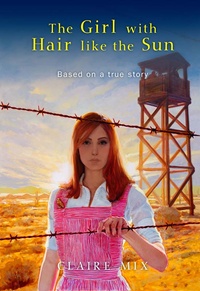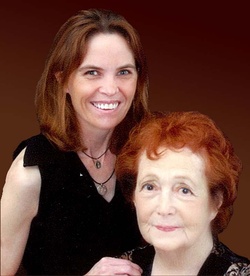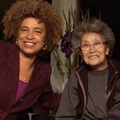Claire Mix will never forget the day she first learned of the harsh realities that Japanese Americans faced during World War II and the role that her mother played in that dark period of United States’ history.
Claire was exposed to this part of history by two people she held in the highest regard—her mother, Ruth Mix and actor, George Takei, best known for his role as Hikaru Sulu on the “Star Trek” series. At thirteen-years old, Claire—a science fiction fanatic and “huge Star Trek fan”—happened to have quite the crush on Mr. Sulu. So when her mother asked her if she wanted to attend an event where George Takei was speaking, Claire answered unequivocally, “Yes! Yes! Yes!”
Unaware of what kind of event it would be, Claire and her accompanying friends arrived decked out in Trekkie garb. They sat in the front row holding a “We Love Sulu” poster with Spock ears perked, waiting in anticipation to hear what Mr. Sulu had to say. Expecting him to speak about “proton torpedoes” or something of the like, much to Claire’s surprise, George Takei talked about things she had never heard of before—things like “internment” during WWII and its unconstitutionality.
Never having learned anything about internment in school, Claire admitted, “I was totally confused.” And her confusion only grew when after Mr. Takei’s suggestion that perhaps Japanese Americans would not have been interned if the Caucasian community had done more to help, Ruth Mix raised her hand to speak. She stood up and began to share some her experiences from her four years volunteering at Gila River War Relocation Center in Mesa, Arizona. As Claire remembered, “she talked about babies that died in her arms and the people with tuberculosis that died and of her friends and of her life there for four years,” which also included the smuggling in of goods to the camp for the internees.
Claire sat there stunned and astonished. And then in words that she will never forget, her Star Trek crush “gripped the side of the podium” and said, “‘Ladies and Gentlemen, I will not attempt to paraphrase what this woman has just told me, but I stand corrected and I apologize.’” Upset and baffled as to why George Takei would be apologizing to her mother, Claire tried to receive some clarity, but Ruth would not talk about it. Claire had to turn to her father for answers, and he explained to her the new concept of “internment” and told her of the courage that her mother and grandmother exemplified during their time at the camp. However, it was not until much later in life that Ruth herself would talk in detail about her experiences at Gila River. But when she finally did, Claire took note.
Claire wrote, produced and directed the award-winning and Emmy-nominated documentary “Gila River and Mama: The Ruth Mix Story” (2011). Using interviews and visual images from internment camps, the film shares some of her mother and grandmother’s experiences at Gila River internment camp and conveys what it was life was like in the camp for the internees. But after the filming ended, Claire felt her work was not yet complete. At the encouragement of her executive producers, Claire novelized her mother’s experiences at Gila River to delve more deeply into Ruth’s personal journey and the relationships she cultivated while there. The outcome was The Girl with Hair like the Sun.
Translated from Japanese, “The Girl with Hair like the Sun” is the nickname given to Ruth during her time volunteering at Gila River. The novel follows a young, redheaded Ruth, inspired by her principled and fearless mother Frida Mix and unwilling to accept that Japanese Americans should be treated in a way any different than how she should be treated. The friendships Ruth develops with internees and the growth of her relationship with her mother add greatly to the emotional richness of the novel, as does the choice to write in the first person narrative. For Claire, the most difficult part about writing this novel “was telling the story through the eyes of my mother [because] at times I felt my mother’s pain.” And the way in which Claire accounts some of her mother’s heart wrenching first-hand experiences evokes similar feelings for the reader, making it near impossible not to be moved to tears by the stories.
When Claire wrote this novel, she did so with students eleven years and older in mind for them read when they are learning about U.S. history. She admitted that her documentary is not as accessible for younger audiences as it is “too mature” for certain age groups, “but the book…even though it deals with death, is appropriate for eleven-year olds on up.” And although targeted at teaching young adults, her novel can also be just as educational and enjoyable of a read for adults.
Other books have become popular tools in the classroom when teaching students of Japanese American internment, and while Claire says that she loves books such as Yoshiko Uchida’s Journey to Topaz and Jeanne and James Houston’s Farewell to Manzanar, her book contributes to the discourse on internment it a different way because it “comes from a another point of view, which validates…those [other] books and the story of every interned Japanese American because my mother was there, she saw it and she’s saying, ‘Yes, these things did happen.’”
And in echoing the hardships of Japanese Americans from a different point of view, Claire believes that Ruth’s story can help speak to and hopefully clarify the facts for those people who compare Japanese internment to the Holocaust and conclude that Japanese Americans ‘didn’t have it so bad’ in comparison. Claire asserts, “You can’t even compare the Holocaust to these internments. They’re not even in the same category. But there were many people, many, many people that were interned, that died because of internment. Babies died because of internment. People died because they were interned. Their businesses, their homes, everything they owned was taken away from them because of the internment.”
Indeed, this novel adds to the discourse on Japanese internment because it contributes to the history of internment from another point of view, but it is in understanding this different perspective that the courage and conviction of Ruth and Frida become all the more apparent and all the more important to us as a nation if we wish to learn from our country’s past mistakes.
Their perspectives at Gila River were defined by their presence at the camp being one of choice, not force. Though they were not interned, they chose to volunteer their efforts at the camp because they felt a responsibility to do what they could for their fellow American citizens who did not have that same choice and were being denied their rights. Though their perspectives inherently came from a privilege afforded to Ruth and her mother by their ethnicity, Claire humbly and gracefully conveys how Ruth and Frida worked every day at Gila River to challenge that privilege and to use it as reason to defend Japanese Americans rather than persecute them.
Ruth and Frida Mix had the courage to not only speak out against what they knew was wrong, but to act upon their beliefs despite the risk and discrimination they themselves faced for doing so in an era plagued with fear and discrimination. The Girl with Hair like the Sun is as much a coming of age story as it is a call to action against injustice for children and adults alike.
It was Ruth’s last wish for Claire to write a book about her experiences at Gila River internment camp, and before she lost her battle against breast cancer in 2007, she told Claire, “You make sure it gets into every hand of every school kid in America.”
“And I made her that promise,” Claire said resolutely, ”so that is my goal.” Carrying the same flame that once ignited her mother and grandmother’s passions, it is a goal Claire Mix will, no doubt, never give up on trying to achieve. And in passing on her mother’s story, perhaps for Claire there is also a sense of hope that children of future generations who grow up in the United States do not have to wait as long as she did to learn of the injustices that took place within the very same borders in which they are raised.
* The Girl with Hair like the Sun is available for purchase at the Museum Store and online. Please visit janmstore.com to order your copy. For more about the author of the book, please visit her website.
© 2012 Mai Tanaka










